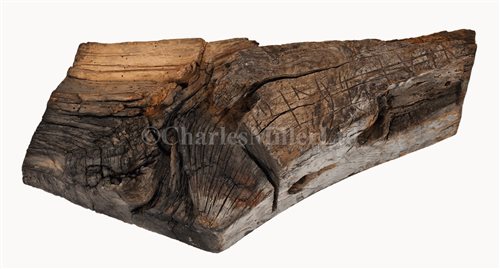3rd Nov, 2015 12:00
Maritime and Scientific Models, Instruments & Art ('Encounter')
51
[M] AN OAK KNEE SUPPORT FROM H.M.S. VICTORY, IN...
the shaped knee with remnant rase marks inscribed [N]o 1792 x 1815 (old pin holes and cut marks, wear, rase marks partially missing, evidence of old worm damage), approximately -- 10 x 35 x 15in. (25.5 x 89 x 38cm.)
Provenance: H.M.S. Victory, removed between 1922 and 1959; sold to Victory Ltd in 2000 and Victory Oak Ltd, 2006.
Literature: McGowan, A: H.M.S. VICTORY / Her Construction and Restoration, Caxton Editions, 1999, p.132.
This beam once formed part of the rider frame assembly and was one of a pair of beams which supported the main knee in the lower hull. The rase marks are hard to determine partly because the lower half of the latter number is missing, it having been carried over on to a sister timber which is long gone, but continuing the straight-line lettering, it is possible to accurately complete them. Whilst the exact location is now lost to history - Timber Masters not recording their numbering systems for posterity - it is thought this one came from the environs of the orlop deck. The beam has witness marks that show it was part of Victory's original construction in 1765; foremost amongst these is the damage caused by using iron pins - normal before copper sheathing was introduced but phased out as refits allowed thereafter. The problem had been recognised in 1768, but it was only in 1783 that the Admiralty actually issued an order to replace iron bolts with copper. The Victory was copper sheathed in 1780 but it was not until her Great Repair of 1800-1803 when approximately 88% of her was replaced that the problem was finally resolved with these deeply embedded sections. In addition, as Victory was nearing completion in 1765, the War with France came to an end and so the rush to complete her was no longer pressing. Laid up in ordinary for several years, there is still evidence of the white wash and green paint used then as a preservative prior to her being fitted for service.
This lot will be available for viewing at Imperial Road
Condition Report
As described; has been treated for worm and is believed to be clear at the time of writing.
We are pleased to provide you with a general report of the condition of this property. Since we are not professional conservators or restorers, we urge you to consult with a restorer or conservator of your choice who will be better able to provide a detailed, professional report. Prospective buyers should inspect each lot to satisfy themselves as to condition and must understand that any statement made by Charles Miller Ltd is merely a subjective, qualified opinion. Prospective buyers should also refer to any Important Notices regarding this sale, which are printed in the Sale Catalogue. NOTWITHSTANDING THIS REPORT OR ANY DISCUSSIONS CONCERNING A LOT, ALL LOTS ARE OFFERED AND SOLD “AS IS” IN ACCORDANCE WITH THE CONDITIONS OF BUSINESS PRINTED IN THE SALE CATALOGUE.
the shaped knee with remnant rase marks inscribed [N]o 1792 x 1815 (old pin holes and cut marks, wear, rase marks partially missing, evidence of old worm damage), approximately -- 10 x 35 x 15in. (25.5 x 89 x 38cm.)
Provenance: H.M.S. Victory, removed between 1922 and 1959; sold to Victory Ltd in 2000 and Victory Oak Ltd, 2006.
Literature: McGowan, A: H.M.S. VICTORY / Her Construction and Restoration, Caxton Editions, 1999, p.132.
This beam once formed part of the rider frame assembly and was one of a pair of beams which supported the main knee in the lower hull. The rase marks are hard to determine partly because the lower half of the latter number is missing, it having been carried over on to a sister timber which is long gone, but continuing the straight-line lettering, it is possible to accurately complete them. Whilst the exact location is now lost to history - Timber Masters not recording their numbering systems for posterity - it is thought this one came from the environs of the orlop deck. The beam has witness marks that show it was part of Victory's original construction in 1765; foremost amongst these is the damage caused by using iron pins - normal before copper sheathing was introduced but phased out as refits allowed thereafter. The problem had been recognised in 1768, but it was only in 1783 that the Admiralty actually issued an order to replace iron bolts with copper. The Victory was copper sheathed in 1780 but it was not until her Great Repair of 1800-1803 when approximately 88% of her was replaced that the problem was finally resolved with these deeply embedded sections. In addition, as Victory was nearing completion in 1765, the War with France came to an end and so the rush to complete her was no longer pressing. Laid up in ordinary for several years, there is still evidence of the white wash and green paint used then as a preservative prior to her being fitted for service.
This lot will be available for viewing at Imperial Road
Auction: Maritime and Scientific Models, Instruments & Art ('Encounter'), 3rd Nov, 2015


